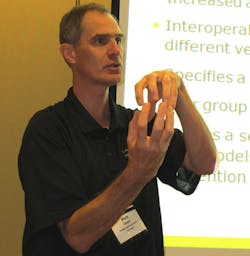Invensys SCADA Applications Poised to Meet Power Industry Smart Grid Challenges
"IEC 61850 has become the defacto standard for substation automation," Mark Grant told an audience of power industry customers at the Tuesday Power Industry Solutions session, IS-POW02, "Invensys Solutions: SCADA in the Power Industry, Current Challenges."Grant, who is product sales executive, SCADA systems, for Invensys Operations Management, noted that while all Invensys Supervisory Control and Data Acquisition (SCADA) offerings are IEC 61850-compliant, the standard to date has so far seen most use in Europe and the Far East. "Frankly, most of the customers that we talk with in the United States don't do much with 61850 at all."Broader use of 61850 represents one of the challenges faced by the U.S. electric power industry, given the numerous benefits of the standard, Grant observed. "It provides a significant amount of power when you're configuring systems," he noted. For those unfamiliar with the standard, he likened 61850 to the Foundation Fieldbus or Hart communication standards, in the sense that "it gives you a lot more information than just the analog or digital input coming in from that device."Among other benefits of using the standard, Grant listed: • Cost Savings for project delivery, as data interfaces replace hard-wired interfaces, with reduced cost of installation• Increased architectural flexibility• Interoperability between devices from different vendors • A specified common configuration interface• User group maintenance support• A defined set of standard object-oriented data models with a structured naming convention.Grant also provided electric industry customers with an overview of SCADA applications provided by Invensys. On the generation side, these include load forecasting, automatic generation control, economic dispatch and cyber security/disaster recovery. Generation management systems provided include automatic generation control, interchange transaction scheduling, economic dispatch, NERC performance monitoring, adaptive load forecasting and unit commitment.For Invensys, applications supplied for the distribution network are where the company sees the greatest amount of smart grid interaction, said Grant, in that Invensys applications don't extend down to the devices within user buildings.In this realm, it is critical to ensure that the right amount of power is being delivered to utility customers, not too much and not too little, he noted, "and there are a number of different applications that we do to make sure that those generators are in fact doing that." The other big issue is keeping the power up and running, not only so that end-users can power their homes and plants, but also so that generators can keep the meters spinning, said Grant. "If those meters aren't spinning as quickly as possible or for as many of the homes as possible, they're in trouble."Invensys applications on the distribution side include power factor control, automatic line sectionalizing, geographical information systems, load shedding, load forecasting, conservation voltage reduction and pole-top RTUs.The auto line sectionalizing is a key enabler to meeting power industry customer goals. "They're looking for a self-healing network," Grant said. "Without this kind of an application, it would be up to the power companies to dispatch people to the part of town where power is out to find out if a car hit a pole, if a tree fell on it, if a squirrel jumped across the lines." With the auto sectionalizing, by contrast, pole-top RTUs that are mounted atop power poles incorporate logic that is able to recognize faults and re-route power so that only the affected section is without power.Summing up, Grant noted that while widespread adoption of IEC 61850 for substation automation represents a challenge for the industry, other challenges include "generating the appropriate amount of power on the feeders, and making sure that you're getting the correct frequency and the correct quality of power. Those are the primary things that we're dealing with our SCADA solutions for distribution automation," he concluded.

